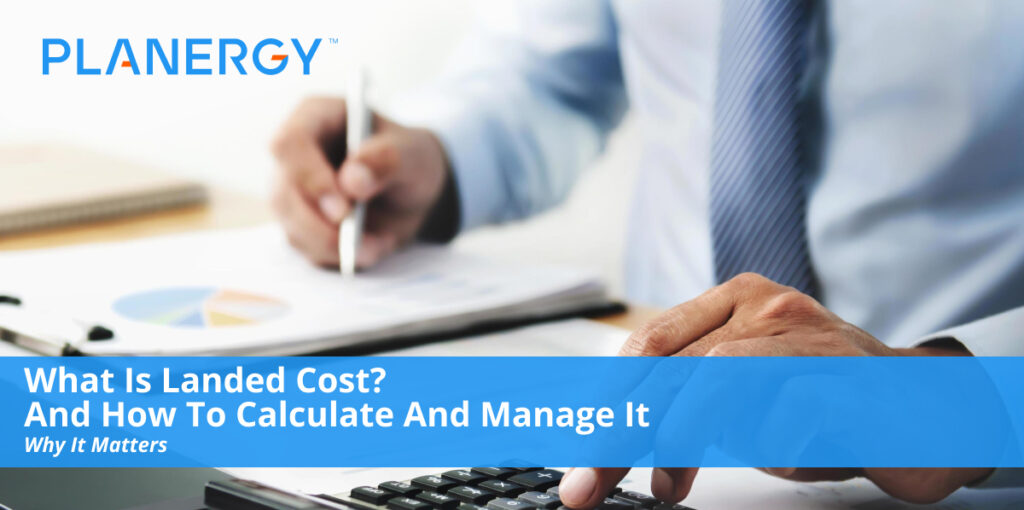Total landed cost, or TLC, total delivered cost, and landed cost, all refer to the same thing.
Any time you hear any of these three phrases, it’s referring to the “sum of all costs associated with making and delivering products to the point where they produce revenue.”
Several factors go into what your landed costs are, such as the industry you’re conducting business in, unit costs, transportation costs, taxes and tariffs, and inventory management costs.
Outside of this, things like corporate income tax, currency exchange rates (sometimes, the USD can make or break a deal), brokerage fees, and even the cost of your carbon footprint play a role.
Why is Landed Cost Important?
The main point of calculating your total landed cost is to find both obvious and hidden costs throughout your supply chain.
Finding a product’s true cost can improve your decision-making on how to get products to the end user in the most cost-efficient way.
For example, if you have a product that is manufactured across a few different countries and you only base your purchasing decision on the cheapest net purchasing cost, you may find that you’re spending more money than you need to.
You have to consider the transportation cost, taxes, tariffs, customs, and a variety of other factors that may be considered hidden costs. With a clear idea of how much your products really cost, your decision-making will be easier. Without knowing your total landed cost, you could be making decisions based on incomplete data.
You know your total landing cost, you’ll have insight into financial performance. You’ll be able to see the true expenses for products and find ways to improve it. This gives you better insight into cost and the cost trade-offs associated with making changes across their supply chain.
Why is Landing Cost Hard to Calculate?
Data shows that the majority of shippers cited that they don’t calculate to TLC because they don’t have the available data, resources, or time. Because there are so many factors that contribute to the equation, many of which can be difficult to obtain, it could be hard to arrive at a final conclusion.
Because a lot of these components aren’t readily available and take effort and time to discover, many people opted to skip this number entirely.
That’s why it’s important to determine all of the factors before attempting to solve the calculation. Of course, this process can be time-consuming. A lot of organizations don’t have the time to calculate within the time constraints that are established before a decision needs to be made.
Plus, the landed cost model has to be constantly updated and it can be hard to understand its true value. That makes it even more difficult to get the support of shareholders.
To add another layer of difficulty, many don’t know how far into the supply chain they should include in the equation.
There isn’t a concrete formula so it’s difficult to determine if everything that should be included has been included. Some formulas that are available are incredibly broad but the more granular you get, the more sophisticated your data will be.
Calculating Landed Cost: Getting Started
Even though calculating landed cost can be difficult, there are several avenues you can use to solve it. Many businesses rely on spreadsheets or internally developed tools to calculate their total landed cost.
You can also find support available from third-party organizations such as supply chain consultants and other supply chain experts.
There is also the option to purchase commercial tools to help you compute the formula, such as enterprise resource planning systems, transportation management systems, supply chain design programs, etc. As the importance of this equation becomes more popular, more tools are incorporating the feature to support calculation.
There is no universal formula – how you calculate it depends a lot on your business and industry.
Begin by collecting as much of the data as you can so that you can start to develop the equation. This gets you moving in the right direction to help you identify the things that are missing from the equation.
Many feel that standing on the sidelines to accumulate data so that they have a higher volume of data will give them a better chance of calculating TLC.
But by starting the process earlier in the beginning of the creation of the formula earlier, it will help you determine what is missing fast. Start with metrics like:
- Payment terms
- Transit time
- Manufacturing lead time
From there, you can start to generate a formula that works best for your organization.
Let’s take a closer look at how it works:
At first glance, if you’re buying 5,000 USB cables:
Supplier 1 charges 50 cents per USB cable, with a 10% discount on bulk orders over 1,000 items. This would cost you $2,250. If you sell each cable at $5, your profit margin is: .91, and you earn a profit of $22,750.
Supplier 2 charges 55 cents per USB cable, with no bulk discounts. This would cost you $2,750, and if you sold each cable at $5, your profit margin would be .89 and you’d earn a profit of 22,250.
Based on price alone, supplier 1 is the winner.
Now, let’s dig a bit deeper:
Supplier 1 charges a flat rate of $500 for international shipping, and since they’re based in a company that doesn’t have any preferential agreements with you, you have an import duty rate of 25%.
Supplier 2, on the other hand, bases their shipping on weight, and your total comes to $250. They’re based in a company with a preferential agreement with yours, so the important duty rate is only 10%.
That means:
Supplier 1’s cost: $2,250 + $500 shipping + ($2,250 *.25) = $2,250 + 500 + 562.5 = $3,312.50
Supplier 2’s cost: $2,750 + 250 shipping + ($2,750*.1) = $2,750 + 250 + 275 = $3275
In this case, supplier 2 (though not by much) comes out to be the better deal after all.
But when you look at the profit margin with these costs factored in, you’ll see more of a difference.
Purchasing from Supplier 1 gives us $21,687.50 in profit, for an 86.75% profit margin.
Purchasing from Supplier 2 gives us $21,725 in profit, for an $86.9% profit margin.
Though that difference is small, when you consider high volume, that’s a lot of money to be lost, simply by taking the deal that seemed better by looking at the surface and factoring in the price of a product alone.
The landed price costs more money than the purchase price, even if you don’t have to deal with importing and customs brokers, and expensive shipment costs.
Without factoring in landed costs, purchasing from supplier 1 gave us an assumed profit margin of 91%, compared to the more accurate 86.75% profit margin.
Supplier 2 gave us an 89% margin, but the more accurate number was much lower at 86.9%. If you had used those figures without the landed costs, your budget would be off.
If you’d purchased from Supplier 1 and estimated your profit margin without considering the landing costs, you may have ended up in a situation like this:
You expected to sell 500,000 USB cables over the course of the year – and with a profit margin of 91%, you’d expect to see $227,500 in profit – or $250,000 in revenue. Therefore, you budget based on this figure. But, thanks to those landing costs, you actually only see $216,875 in profit, meaning that you’re left with a $10,625 difference to account for.
To help you get started, here is a simple formula to use for landed cost calculation:
Item Price + Shipping Costs/Freight Costs + Customs Duties + Risk + Overhead = Landed Cost
If you’re not dealing in your native currency, you’ll also have to work currency conversion into the equation.
You’ll need to address this landing cost calculation with every single product you sell. The cost of the products is much more than the wholesale price – especially if you are dealing with extra fees because of extended customs clearance times.
Sellers who are exporting products also have to deal with fees, which they tend to add to the cost of goods when deciding on their pricing.
Don’t forget to factor in handling fees, harbor fees, payment processing fees, freight rates, etc. into the total price as you set your safety stock and determine profitability on any product.
After you contribute the time and resources to determine your landing costs, your company will start to see the benefits.
Spending a bit of extra time on landed costs when you’re doing your due diligence with suppliers, especially when it comes to the global trade and imported goods, will pay off in the long run.




